偏向報道とは?
この風刺画について
この風刺画「偏向報道(Biased reporting)」は、現代メディアにおける報道の「切り取り方」や「伝え方の偏り」に対する問題提起を込めて描きました。
私がこの作品を描こうと思ったきっかけは、同じ出来事でも報道の仕方ひとつで全く異なる印象を受けることが多いと感じたからです。
特に社会的に敏感なテーマについては、真実よりも「誰が語るか」や「どの角度から切り取るか」が強調され、客観性が後回しにされる傾向があると感じました。
この風刺画は3つで構成されています。
左の風刺画では、多数の赤い旗を掲げた人々が押し寄せる中、報道陣はただ一人のスーツ姿の男性だけに注目しています。
中央の風刺画では、その男性が白旗を掲げ、レポーターに囲まれて「中立的に見える」報道が行われていますが、実際はその周囲にある赤い旗の熱狂は伝えられていません。
そして右の風刺画では、地面には倒れた人々が多数存在しているにもかかわらず、メディアは白旗を持った人物だけをクローズアップして報道しています。
この一連の流れは、報道がいかに視聴者の印象をコントロールしているか、そしてその報道によって真実がどれだけ歪められているかを可視化する試みです。
「報道は事実を伝えるもの」という理想が、現実には「見せたい事実を伝えるもの」になっていないか。
この風刺画を通じて、視聴者自身がその問いに気づくことを意図しています。
風刺画のポイント
この風刺画を制作する上で、私が最も意識したのは「情報の見え方が全てを決める」という点です。
同じ出来事であっても、どこをどう切り取るかで、その意味や印象は大きく変わってしまいます。
報道機関がカメラをどこに向けるか、マイクを誰に向けるか、それによって真実の全体像は伝えられず、一部の印象が「事実」として視聴者に届いてしまうのです。
この問題を視覚的に理解してもらうために、まず左側の風刺画では、「本当に何が起きているか」を見せず、「誰に注目が集まっているか」だけを描きました。
ここでは、報道陣が必死に一人の男性にカメラを向けていますが、その背後には無数の群衆と赤い旗が存在しています。
つまり、「画面の外側にある現実」が一切無視されている構図です。
中央の風刺画では、報道されている内容が「いかにも中立的に見える」ように演出されています。
白旗を掲げる人物を中心に据えることで、視聴者に「冷静な解決者」のようなイメージを持たせていますが、背景の群衆の圧倒的な数や熱狂ぶりには一切触れていません。
この風刺画は、ニュース番組などで使われる「編集された映像」の一場面を象徴しています。
そして右の風刺画では、視点を完全に変えています。
カメラの向いている方向の裏側には、血を流し倒れている人々が描かれており、現実の深刻さを暗示しています。
しかし、報道の焦点は依然として白旗を持つ人物に当てられており、「この人がすべてを平和的に解決した」という印象操作が行われています。
この構図により、報道が意図的に「安心感」や「一面的なストーリー」を提供し、本質的な問題や対立を隠す手法があることを描いています。
私がこの風刺画で最も伝えたかったのは、「情報を受け取る側のリテラシー」の重要性です。
受け取った情報を鵜呑みにせず、自分の視点で何が省かれ、何が強調されているのかを見極める力。
それこそが、情報化社会を生き抜く上で必要な「もう一つの目」だと信じています。
この作品が、視聴者や読者が情報を「どう見るか」について一歩踏み込んで考えるきっかけになれば幸いです。
AIが描いた「偏向報道」
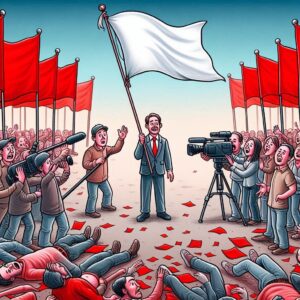 |
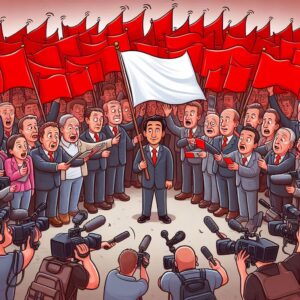 |
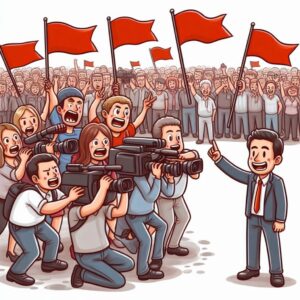 |
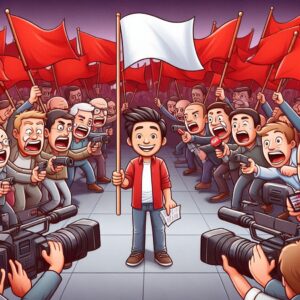 |
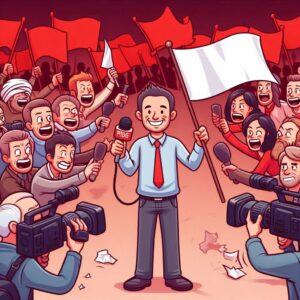 |

コメント